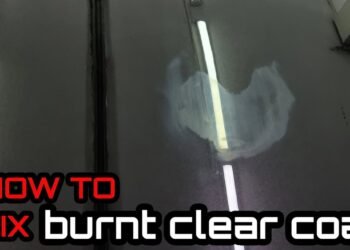If you’ve noticed that bumpy, uneven texture on your car’s paint called “orange peel,” you’re not alone—and simply adding a clear coat on top won’t fix it. You might be wondering why your paint doesn’t look as smooth and glossy as you hoped, even after applying that shiny clear coat.
The truth is, clear coat alone can’t hide those surface imperfections. To truly get that flawless, mirror-like finish you want, you need to understand the right steps to tackle orange peel the right way. You’ll learn why just one clear coat won’t do the trick, and discover the proven techniques that professionals use to eliminate orange peel for good.
Keep reading—your car’s perfect shine is closer than you think.
Causes Of Orange Peel
Orange peel appears as a bumpy texture on painted surfaces. It looks like the skin of an orange, hence the name. Understanding what causes orange peel helps in preventing and fixing it. The problem often starts before the clear coat is applied. Several factors affect the smoothness of the paint, leading to this uneven finish.
Surface Texture Issues
Surface texture plays a big role in orange peel formation. If the base layer is rough or dirty, the clear coat will highlight these flaws. Dust, dirt, or grease on the surface can stop the paint from leveling properly. Even small bumps or scratches can cause the clear coat to dry unevenly. This results in a textured, orange peel effect.
Impact Of Metallic Paints
Metallic paints contain tiny flakes that reflect light. These flakes can cause waviness in the paint film. When clear coat is sprayed over metallic paint, it may not fully smooth out the surface. The clear coat follows the uneven pattern of the metallic flakes. This makes orange peel more noticeable with metallic finishes.
Application Errors
Errors during paint application are a common cause of orange peel. Spraying too thick or too thin can lead to uneven drying. Using wrong spray gun settings affects the paint flow. Paint drying too fast or too slow also creates texture issues. Poor technique, such as holding the gun too far or too close, can cause paint to dry unevenly. These mistakes result in a rough clear coat finish.
Why Clear Coat Alone Falls Short
Clear coat is essential for protecting car paint and adding shine. Yet, it cannot fix every problem on its own. Orange peel texture is one such issue where clear coat alone falls short. This texture creates a bumpy surface that a single clear coat layer cannot smooth out.
Applying clear coat over orange peel only covers the rough surface. The uneven texture remains visible through the clear coat. This makes the paint look dull and uneven, not smooth and glossy.
Visible Underlying Flaws
Orange peel is caused by uneven paint drying or spraying. These surface flaws are beneath the clear coat layer. A new clear coat only hides the color, not the texture. The bumps and valleys of the orange peel show through clearly. It keeps the paint from having a perfect, mirror-like finish.
Light Refraction Problems
Light behaves differently on smooth and bumpy surfaces. Orange peel causes light to scatter unevenly. This scattering reduces shine and clarity in the paint. A single clear coat cannot fix how light bends on the rough surface. The paint looks cloudy or dull despite the clear coat.
Limitations With Single Coat
One layer of clear coat is too thin to fix texture issues. It follows the shape of the paint beneath. Without extra thickness, it cannot fill in or level out the orange peel. Proper repair needs sanding and polishing after multiple clear coats. This process smooths the surface and brings back high gloss.
Preparing For A Smooth Finish
Preparing for a smooth finish is key to a flawless clear coat over orange peel. Proper steps taken before applying clear coat reduce surface imperfections. The goal is to create an even base, which helps the clear coat lay flat and shine. Neglecting preparation leads to visible texture and dullness under the clear layer. Follow these steps for a professional finish that looks polished and smooth.
Proper Base Coat Application
Apply the base coat evenly to avoid bumps and waves. Use light, mist coats first to build a thin layer. Let each coat dry before adding the next. Avoid heavy layers that cause runs or orange peel texture. Maintain a consistent distance between the spray gun and surface. This ensures a smooth, uniform base for the clear coat.
Curing And Drying Tips
Allow the base coat to dry fully before clear coating. Proper curing time prevents trapping solvents under the clear coat. Drying in a dust-free, well-ventilated area helps avoid imperfections. Follow manufacturer drying times exactly for the best results. Rushing this process can cause the clear coat to bubble or peel.
Choosing The Right Clear Coat
Select a clear coat designed for smooth finishes and durability. Consider products with good flow and leveling properties. Choose a clear coat compatible with your base paint type. High-quality clear coats reduce the chance of orange peel texture appearing. Follow application instructions carefully for optimal results.

Credit: www.youtube.com
Wet Sanding Techniques
Wet sanding techniques are essential for smoothing out orange peel texture on clear coats. This process helps create a flat, even surface before polishing. Proper wet sanding removes peaks and valleys without damaging the paint beneath. It requires patience, the right tools, and careful attention to detail.
Selecting Grit Levels
Choose sanding grits based on the severity of the orange peel. Start with a coarser grit like 1000 or 1500 for heavy orange peel. Use finer grits such as 2000 or 3000 for light orange peel or finishing. Always soak the sandpaper in water for at least 10 minutes before use. This reduces scratches and keeps the surface cool during sanding.
Sanding Process Steps
Begin by washing the surface to remove dirt and debris. Use gentle, circular motions to sand the clear coat evenly. Keep the surface wet to avoid sanding too deep. Frequently wipe the area to check progress. After initial sanding, switch to finer grits to smooth out scratches. Finish by drying the surface completely before polishing.
Avoiding Common Mistakes
Do not apply too much pressure; it can cut through the clear coat. Avoid sanding dry as it causes deep scratches. Do not rush; slow, careful movements yield better results. Never skip finer grit steps; they remove scratches from coarser grits. Always test a small area first to prevent damage. Proper technique protects the paint and improves gloss after polishing.
Polishing For Gloss And Depth
Polishing is essential to enhance the gloss and depth of a clear coat over orange peel. This step smooths out the surface, reducing texture and bringing out a rich shine. Proper polishing transforms dull paint into a reflective, eye-catching finish. The process involves careful use of compounds and tools to restore the clear coat’s brilliance.
Using Cutting And Polishing Compounds
Cutting compounds remove the roughness caused by orange peel and sanding marks. They work by gently abrading the surface to level peaks and valleys. After cutting, polishing compounds refine the finish by removing fine scratches. Together, these compounds help produce a smooth and glossy surface.
Buffing Tools And Methods
Buffing tools speed up the polishing process and improve results. Dual-action polishers are popular for their safety and ease of use. Use soft foam pads for polishing to avoid new scratches. Apply compounds evenly and use steady, overlapping motions. Avoid pressing too hard to protect the clear coat.
Restoring Shine Effectively
Start with cutting compound to flatten the orange peel texture. Follow with polishing compound to enhance gloss and clarity. Clean the surface between steps to remove residue. Finish with a clean microfiber cloth to reveal a deep, mirror-like shine. Regular maintenance keeps the clear coat looking fresh and vibrant.

Credit: www.drbeasleys.com
Applying Multiple Clear Coats
Applying multiple clear coats is key to achieving a smooth, glossy finish over orange peel texture. Each layer adds depth and thickness to the paint job. This buildup helps in correcting surface imperfections later. Applying clear coats properly improves the final look and durability.
Mist Vs. Wet Coats
Mist coats are thin and light. They help the next coat stick better. These coats dry quickly and prevent runs or sags. Wet coats are heavier and thicker. They add more clear coat material to the surface. Wet coats build up the paint’s thickness faster. Use mist coats first, then follow with wet coats for best results.
Building Thickness For Correction
Orange peel requires enough clear coat thickness to fix. Thin clear coats will not allow sanding without cutting through. Multiple coats create a thick, even layer. This thickness lets you wet sand and polish effectively. Building thickness in layers helps hide the orange peel texture. It also protects the paint beneath from damage.
Timing Between Coats
Timing is important when applying clear coats. Each coat must dry before applying the next. Too soon, and the layers may run or wrinkle. Too late, and the coats may not bond well. Follow the manufacturer’s instructions for drying times. Usually, 10 to 20 minutes between coats works well. Proper timing ensures a smooth, durable finish.
Common Pitfalls To Avoid
Applying a clear coat over orange peel requires careful attention. Mistakes can ruin the finish and waste time and materials. Avoiding common pitfalls helps achieve a smooth, glossy surface. Below are key errors to watch out for during the process.
Rushing The Process
Clear coating needs patience. Spraying too fast or applying thick coats causes uneven layers. This creates more orange peel rather than fixing it. Let each coat dry fully before adding the next. Slow, steady work gives the best results.
Skipping Sanding Steps
Sanding is crucial to remove bumps and roughness. Skipping or doing a quick sanding leaves orange peel beneath the clear coat. Use fine grit sandpaper and sand evenly. This step smooths the surface and prepares it for polishing.
Overusing Polishing Compounds
Polishing compounds remove scratches and restore shine. Using too much or polishing too hard can thin the clear coat. This damages the paint and causes swirl marks. Use small amounts and gentle pressure to protect the finish.

Credit: erapaints.com
Maintenance Tips For Lasting Finish
Maintaining a clear coat over orange peel requires consistent care to preserve its shine. Proper upkeep prevents dullness and protects the paint surface. Follow these simple maintenance tips to keep your finish looking fresh and smooth for longer.
Regular Cleaning Practices
Clean the surface often using a gentle car wash soap. Avoid harsh detergents that can strip the clear coat. Use a soft microfiber cloth or sponge to reduce scratches. Rinse thoroughly to remove all dirt and soap residue. Dry with a clean, soft towel to prevent water spots.
Protective Waxing
Apply wax every few months to shield the clear coat from UV rays and contaminants. Use a high-quality car wax suitable for clear coats. Waxing adds a protective layer that enhances gloss and smooths minor texture. Always follow the product instructions for best results. Buff gently to bring out a deep shine.
Addressing Minor Imperfections
Inspect the clear coat regularly for small scratches or dull spots. Use a mild polish to remove light imperfections and restore smoothness. Avoid aggressive rubbing that can damage the clear coat further. For deeper flaws, consider professional wet sanding and buffing. Quick attention keeps the finish looking flawless and fresh.
Frequently Asked Questions
Can You Fix Orange Peel With Clear Coat?
A single clear coat cannot fix orange peel; it only covers the texture. Proper repair requires wet sanding and polishing the clear coat to smooth the surface and restore gloss. Applying multiple clear coats during painting helps achieve a finish suitable for sanding and polishing later.
What Grit To Remove Orange Peel From Clear Coat?
Use 1500 to 2000 grit wet sandpaper to remove orange peel from clear coat. Sand gently until smooth.
How To Fix Orange Peel Finish?
Fix orange peel by wet sanding the clear coat with fine grit sandpaper. Then, polish using a cutting compound and buff to restore shine. Apply multiple clear coats initially to allow sanding and polishing for a smooth finish. Avoid relying on a single clear coat to hide orange peel.
Is Orange Peel In The Base Coat Or Clear Coat?
Orange peel appears in the clear coat, not the base coat. It results from uneven clear coat application and surface texture.
Can Clear Coat Hide Orange Peel Texture On Car Paint?
No, clear coat only covers the surface; it does not remove orange peel texture underneath.
Conclusion
Fixing orange peel requires more than just one clear coat layer. Start by sanding the clear coat to smooth out the texture. Then polish the surface to restore the shine and remove scratches. Applying multiple clear coats during painting helps build a thick layer for sanding later.
This process creates a smooth, glossy finish that hides imperfections. Patience and proper steps make a big difference in paint quality. Clear coat alone won’t hide orange peel, but careful sanding and polishing will. This approach ensures your paint looks smooth and professional every time.

















